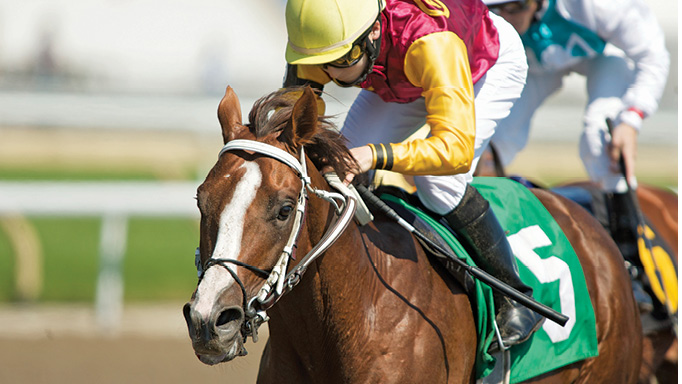Head Chopper is not the average high-strung, bossy thoroughbred stallion.
A casual visitor to the stallion’s home in Kleinburg, ON, will see the blazed-faced chestnut in a paddock with a younger mate, one of his sons, in fact. Head Chopper lives outside all day, every day, but when he hears the voice of his owner, Steve Owens, he quickly goes to meet his best friend.
Owens, who bought the now 12-year-old stallion as a yearling, raced the consistently good horse in partnership and then retired him at the end of his six-year-old season. Almost as a lark, Owens allowed Head Chopper to breed to two of his mares every year. The results have been remarkable.
From four foals of racing age in 2014, Head Chopper had two stakes winners both owned by Owens and one of them, London Tower, is a contender for the 2015 Woodbine Oaks.
“We’ve been lucky,” said Owens, who has been a successful trainer at Woodbine soon after taking out his license in 1988. “I am very proud of Head Chopper. We had fun when he was racing and we are still having fun.”
As a reward for passing on some super genes to Owens’ mares, Head Chopper will be offered to the public for the 2015 breeding season. There had been half a dozen bookings to the stallion by the time Owens had put away the Christmas tree.
Head Chopper was foaled at Shannondoe Farms in St. Thomas, ON, a successful breeding operation owned by James and Janeane Everatt and their daughter Arika Everatt-Meeuse. The colt was a son of Mutakkdim, a Kentucky stallion at Hill ‘n’ Dale Farms, out of the mare Raphael Rose by Pro Consul. He attracted the attention of Owens at the 2004 Canadian Thoroughbred Horse Society yearling sale.
“I had partners, Camilla Farm and a numbered stable of Martin Dinkin, and we were looking for runners,” said Owens. “I liked the way he looked and I really liked his sire.”
As a sire of over 100 stakes winners, Mutakkdim offspring were often in demand. A bid of $35,000 (Can.) and the colt went home with Owens.
Head Chopper proved to be a slow learner who was plagued with baby problems and Owens did not rush the colt to racing. He raced twice as a juvenile, but then was put away for the year.
Once Head Chopper matured and stretched out to route distances, he realized his potential. He won two allowance races and was improving quickly and that was when Owens sent him out to Hastings Park in Vancouver for the B.C. Derby (Grade 3).
After dishing out his half of $20,000 for the shipping (he shared with fellow Woodbine runner Ok Nothanksforaskn, trained by Lorne Richards), Head Chopper drew post 12, a virtually impossible spot in the gate on the 5-furlong Hastings oval.
He finished second, beaten a scant nose.
As a five-year-old, Head Chopper won the Elgin Stakes for yearling sale graduates and finished the year in the Mountaineer Mile. He continued to be competitive at the allowance class as a six-year-old before Owens retired him. Head Chopper earned over $450,000 from five wins in 30 races.
“He had a blind splint in one leg all his career and he was getting sore on it,” said Owens. “He could have kept running, but I had always planned to retire him to our farm.”
Owens became sole owner of the horse and then took a chance and bred two of his three mares to the stallion.
“I never felt the need to geld him as a racehorse and I have gelded a lot of horses in my training years,” said Owens. “He was very manageable and cooperative.”
Owens introduced the mares to Head Chopper in a round pen or sent them on an “afternoon date” in the paddock and both had foals in 2011. One of them, Zazinga, from the Owens-bred mare Town Dance (by Dance Brightly), won the La Prevoyante Stakes at one mile on the grass in 2014.
Head Chopper had two more foals in 2012: Hutchy was placed as a two-year-old and London Tower won the Ontario Lassie Stakes late in 2014. London Tower’s dam, Mrs. Donaghy, is an unraced daughter of Military and was just a $10,000 yearling purchase.
Owens said he is excited that Head Chopper will get a bit more business in 2015 (his fee is listed at $4,500).
“It takes time to develop these young horses and we do it all on our farm,” said Owens. “(The progeny) get to spend a lot of time outside and we break them ourselves on the farm and get them started. It’s a bit of luck and perseverance more so than a master plan.”


